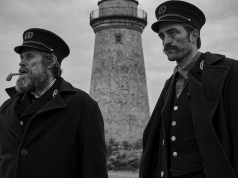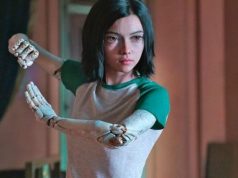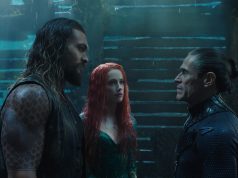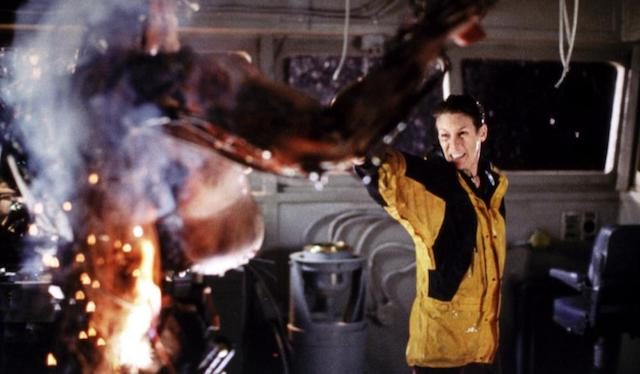
Ever since man first gazed heavenward and sought to explore the outer reaches of space, he has been troubled by one forbidding thought: What if an alien life form commandeers our spacecraft, uses our satellite system to transport itself to Earth, and then turns all the humans into cyborgs? WHAT THEN?? That is the question that kept early astronomers awake at night.
I’m sorry to report that this is exactly what occurs in “Virus,” a laughable and icky sci-fi horror film from 1999 that was based on a comic book series. Perhaps it made more sense in that format than it does as a movie. After all, most of the successful stories about super-intelligent electricity-based aliens that seek the destruction of mankind are found in comic books, or Dianetics.
The first part of the movie is about Russians, and they’re actually speaking Russian, and none of them are Jamie Lee Curtis, who you know darn well is in this movie, so you figure this is just the warm-up for the real movie. Sure enough, a bolt of space-lightning strikes the Mir space station. It zaps everyone onboard and then follows the satellite link down to the research ship in the Pacific Ocean that was communicating with the Mir. If I understand the science involved here, I believe what happened was the Mir faxed some lightning to a boat.
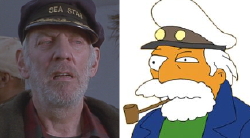
The people that the movie is actually about are on a tugboat called the Sea Star. In accordance with maritime tradition, I will refer to all seagoing vessels as females, because this is quaint. The captain, named Everton (Donald Sutherland), is vaguely Irish, emphatically drunk, and occasionally suicidal. He’s a bearded old salt who looks like the sea captain on “The Simpsons” and loves nothing more than sailing the seven seas, unless it’s drinking the seven liquors. His navigator is Kit Foster, played by Jamie Lee Curtis, tolerating no nonsense from anyone, and wearing her manliest haircut. Everton’s first mate, or whatever it’s called on a tugboat — assistant tugger? — is Steve Baker, played by William Baldwin, best known for his failure to be Alec Baldwin. There are some other crew members, too, but eh.
The ol’ Sea Star, well, she gets caught in a typhoon while she’s tuggin’ a cargo ship (IF YOU KNOW WHAT I MEAN), and Baker urges Everton to cut her (the cargo ship) loose, lest she (still the cargo ship) sink the Sea Star. “That cargo goes down, we go down with it!” Baker declares. “That’s a chance I’ll take!” Everton declares back. This declaring, and all the declaring like it that occupies much of the film, is done in a growling-tough-guy-Clint-Eastwood-y voice. Then Everton pulls a gun on Baker, which surely violates workplace laws even on the open seas, and which leads to this manly exchange:
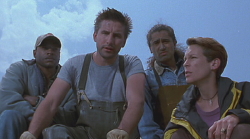
BAKER: Let me tell you something, you ever put a gun in my face again…
EVERTON: Then what?
BAKER: You figure it out.
I’m too macho to make specific threats! I let my ellipses do the work for me!
The question of whether to cut the cargo ship loose is rendered moot when the typhoon breaks her loose herself (I’m assuming typhoons are ladies, too) and sends her to the bottom of the ocean. Now the Sea Star is unhindered by the added weight, but Capt. Everton is financially ruined and grumpier than before. But Fate, who I guess might as well also be a woman, smiles benevolently and femininely upon Everton and his crew, and she leads them to that Russian ship from before. With no one left alive on her, she’s considered abandoned property, free to be claimed by Everton and the crew and sold back to the Russians for millions of dollars. When Fate closes a door, she opens a window! Which probably defeats the purpose of closing the door. Come on, Fate, I’m not paying to air-condition the whole neighborhood.
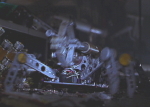
Anyhoo, the Russian ship, a research station full of laboratories and robotics and stuff, is now deserted and spooky, so Capt. Everton sends some secondary employees down to the engine room to investigate, unaware of how such strategies usually pan out. Squeaky (Julio Oscar Mechoso), the crew member who was friends with Baker, I think, sees a spider-like robot skittering around and follows it into a small, dark, confined space, whereupon Squeaky is murdered. Goodbye, Squeaky, the crew member who was friends with Baker, I think!
So: robot spiders. Apparently.
Back up top, the Sea Star folks find a jittery Russian named Nadia (Joanna Pacula), the only survivor of whatever attacked the ship, which latest reports indicate may have been robot spiders. Nadia declares helpful things like, “You’re all going to die!” She also spells out what’s going on: the space-lightning was a living thing, a life form that’s electricity-based rather than carbon-based. After it zapped itself down to the ship, it took up residence in the computers, learned everything about humans, and started making robot spiders out of parts of machinery it found in the robotics labs. This alien thing, being made out of electricity, can use electricity to control other mechanical things, probably because other mechanical things are wusses with no will of their own.
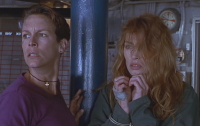
Oh, and you know what else Electric Space Monster does? It captures humans and turns them into human-robot hybrids to do its bidding. That’s what it did to Squeaky, who shows up as a cyborg killing machine that can only be stopped by, um, shooting him. So they shoot him, and he’s dead (again). Not exactly terminators, these Electric Space Monster-designed cyborgs.
Everyone’s pretty worked up about the whole situation. People are scared, they’re trapped on this creepy Russian ship because the Sea Star sank — did I not mention that? Well, it did, because the ESM made the Russian ship drop her anchor on the Sea Star, smashing a hole in her. So the Sea Star crew is stuck here now, and panic sets in. Baker declares, “We gotta get to the computer if we want to kill this thing!” (THRILL to the breathless getting-to-the-computer action!)
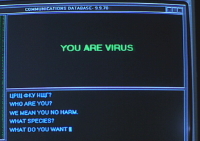
The plan is to type questions into the computer and hope the ESM answers them, because this makes sense. Turns out that as malevolent beings go, the ESM is fairly chatty. It helpfully explains that humans are a “virus” upon the Earth and are only good for spare parts in the construction of cyborgs. It’s your basic alien-disapproves-of-humans-and-wants-to-exterminate-them scenario, as found in such classic texts as “Independence Day” and the Old Testament.
Kit Foster, Steve Baker, and the others get to work figuring out a way to kill the ESM. But not Capt. Everton! Everton, for one, welcomes our new alien overlords, and he strikes a deal with the ESM. For his part, he promises to help the ESM make it to land, where it can dwell in our electrical infrastructure and kill us all. In exchange for his help, the ESM turns Everton into a cyborg … which I kind of suspect is what it was going to do anyway. So I don’t know what Everton is getting out of this, unless he always wanted to be a cyborg.
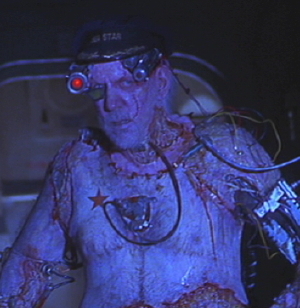
The important thing is that even after he becomes a cyborg, he’s still wearing his captain’s hat. Inhuman killing machine or not, Everton’s first (possibly second) love will always be the sea. (No word on whether cyborgs can drink.)
It’s hard to believe someone thought it was a good idea to dress Donald Sutherland like a robot at all, let alone during the climax of a movie, when audience members are not supposed to be giggling. But it’s also hard to believe that this Electric Space Monster business was ever going to make sense. Sometimes it lives in the ship’s computer; sometimes it’s in the electrical system; either way, turning off the ship’s power doesn’t stop it, and it can control mechanical things that aren’t connected to any wires, apparently through some kind of ESM ESP. Is that scary? I dunno. The whole thing sounds like strident anti-electricity propaganda to me.
Note: Jamie Lee Curtis is supposed to be the lead, but her character doesn’t do anything except look stern. Also, it’s implied that she and William Baldwin are romantically involved, but come on, I can only suspend my disbelief so far.
— Film.com


